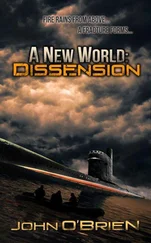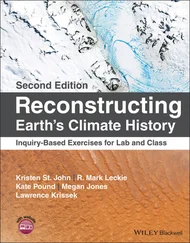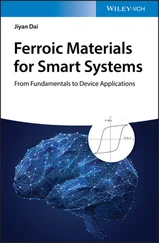John O'Brien - Earth Materials
Здесь есть возможность читать онлайн «John O'Brien - Earth Materials» — ознакомительный отрывок электронной книги совершенно бесплатно, а после прочтения отрывка купить полную версию. В некоторых случаях можно слушать аудио, скачать через торрент в формате fb2 и присутствует краткое содержание. Жанр: unrecognised, на английском языке. Описание произведения, (предисловие) а так же отзывы посетителей доступны на портале библиотеки ЛибКат.
- Название:Earth Materials
- Автор:
- Жанр:
- Год:неизвестен
- ISBN:нет данных
- Рейтинг книги:5 / 5. Голосов: 1
-
Избранное:Добавить в избранное
- Отзывы:
-
Ваша оценка:
- 100
- 1
- 2
- 3
- 4
- 5
Earth Materials: краткое содержание, описание и аннотация
Предлагаем к чтению аннотацию, описание, краткое содержание или предисловие (зависит от того, что написал сам автор книги «Earth Materials»). Если вы не нашли необходимую информацию о книге — напишите в комментариях, мы постараемся отыскать её.
Earth Materials,
Earth Materials,
Earth Materials — читать онлайн ознакомительный отрывок
Ниже представлен текст книги, разбитый по страницам. Система сохранения места последней прочитанной страницы, позволяет с удобством читать онлайн бесплатно книгу «Earth Materials», без необходимости каждый раз заново искать на чём Вы остановились. Поставьте закладку, и сможете в любой момент перейти на страницу, на которой закончили чтение.
Интервал:
Закладка:
In this section, we have discussed the major layers of the geosphere, their composition, and their mechanical properties. This model of a layered geosphere provides us with a spatial context in which to visualize where the processes that generate earth materials occur. In the following sections we will examine the ways in which all parts of the geosphere interact to produce global tectonics. The ongoing story of global‐scale tectonics is one of the most fascinating tales of scientific discovery in the last century and new discoveries continue to be made in this one.
1.5 GLOBAL TECTONICS
1.5.1 Introduction
Plate tectonic theory has profoundly changed the way geoscientists view Earth and provides an important theoretical and conceptual framework for understanding the origin and global distribution of igneous, sedimentary, and metamorphic rocks ( Chapters 7– 18). It also helps to explain the distribution of diverse phenomena that include faults, earthquakes, volcanoes, mountain belts, mineral deposits, and even the evolution of life and the evolving composition of the atmosphere.
The fundamental tenet of plate tectonics(Le Pichon 1968; Isacks et al. 1968) is that the lithosphere is broken along major fault systems into large, relatively rigid pieces called plates that move relative to one another. The existence of the strong, breakable lithosphere permits plates to form. Most plates are huge, with areas of 10 5–10 8km 2and thicknesses that average ~10 3km; some plates are smaller and microplates are smaller still. The fact that they overlie a weaker, slowly flowing asthenosphere permits them to move very slowly. Each plate is separated from adjacent plates by plate boundary segmentsthat end in triple junctions(McKenzie and Morgan 1969) where three plates are in contact ( Figure 1.3).
The relative movement of plates with respect to the boundary that separates them defines three major types of plate boundary segments ( Figure 1.4) and two hybrids: (1) divergent plate (2) convergent, (3) transform, (4) divergent‐transform hybrid, and (5) convergent‐transform hybrid.
Each type of plate boundary produces a characteristic suite of features and Earth materials. This relationship between the kinds of Earth materials formed and the plate tectonic settings in which they are produced provides a major theme of the chapters that follow.
1.5.2 Divergent plate boundaries
Divergent plate boundariesoccur where two plates are moving apart relative to their boundary ( Figure 1.4a). Such areas are characterized by horizontal extension and vertical thinning of the lithosphere. Horizontal extension in continental lithosphere is marked by continental rift systemsand in oceanic lithosphere by the oceanic ridge system.
Continental rifts
Continental riftsform where large‐scale horizontal extension occurs in continental lithosphere ( Figure 1.5). In such regions, the lithosphere is progressively stretched and thinned. A candy bar being very slowly stretched in two is a crude metaphor. This stretching occurs by brittle, normal, and detachment faulting near the cooler surface and by ductile flow at deeper, warmer levels. Long‐term extension is accompanied by uplift of the surface as the hot asthenosphere rises under the thinned lithosphere. Rocks near the surface of the lithosphere that rupture along normal and detachment faults produce continental rift valleys. The East African Rift, the Rio Grande Rift in the United States and the Dead Sea Rift in the Middle East are modern examples of continental rift valleys.
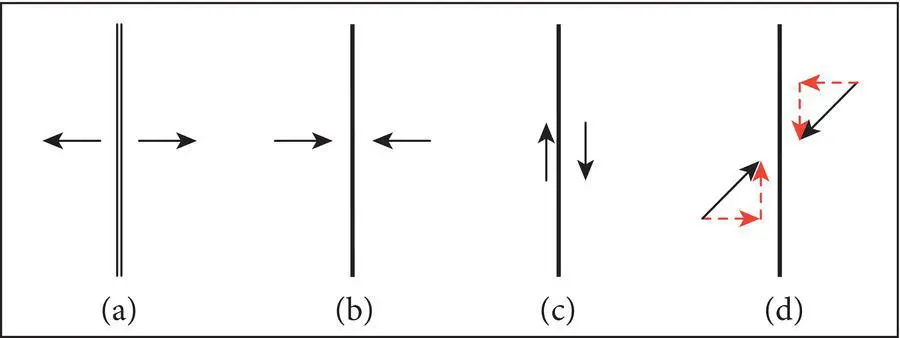
Figure 1.4 Principal types of plate boundaries: (a) divergent; (b) convergent; (c), transform; thick lines represent plate boundaries and black arrows indicate relative motion between plates; (d) hybrid convergent‐transform boundary; red arrows show components of convergent and transform relative motion.
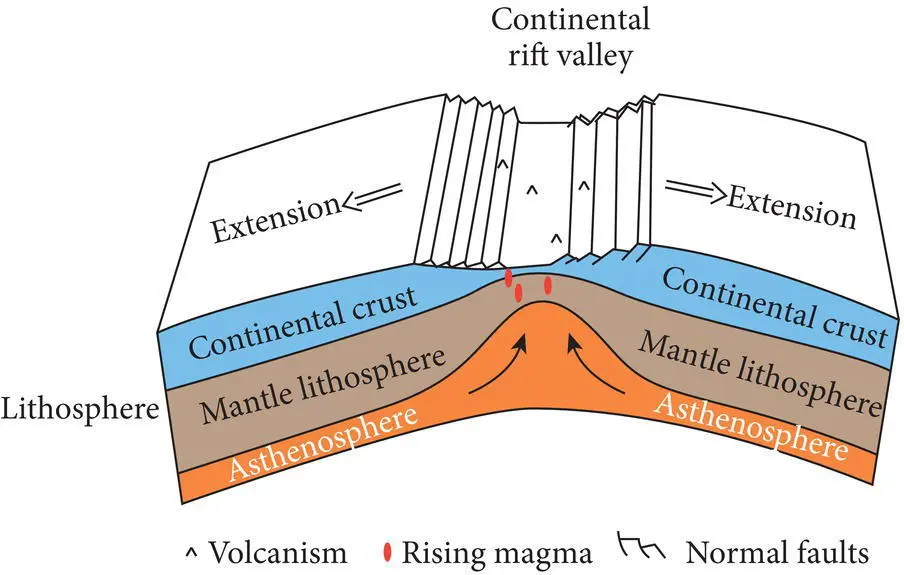
Figure 1.5 Major features of continental rifts include rift valleys, thinned continental crust (blue) and lithosphere (brown) with volcanic‐magmatic activity from melts generated in rising asthenosphere (burnt orange).
If horizontal extension and vertical thinning occur for a sufficient period of time, the continental lithosphere may be completely rifted into two separate continents. Complete continental riftingis the diachronous process by which supercontinents such as Pangea and Rodinia were broken into smaller continents such as those we see on Earth's surface at present. When this happens, a new and growing ocean basin begins to form between the two continental fragments by the process of sea floor spreading( Figure 1.6). The most recent example of this occurred when the Saudi Arabian Peninsula separated from Africa to produce the Red Sea basin some 5 Ma. Older examples include the separation of India from Africa to produce the northwest Indian Ocean basin (c. 115 Ma) and the separation of the Americas from Africa to produce the Atlantic Ocean basin (beginning c. 190 Ma). Once the continental lithosphere has rifted completely, the divergent plate boundary is no longer situated within continental lithosphere. Its position is instead marked by a portion of the oceanic ridge system where oceanic crust is produced and grows by sea floor spreading ( Figure 1.6).
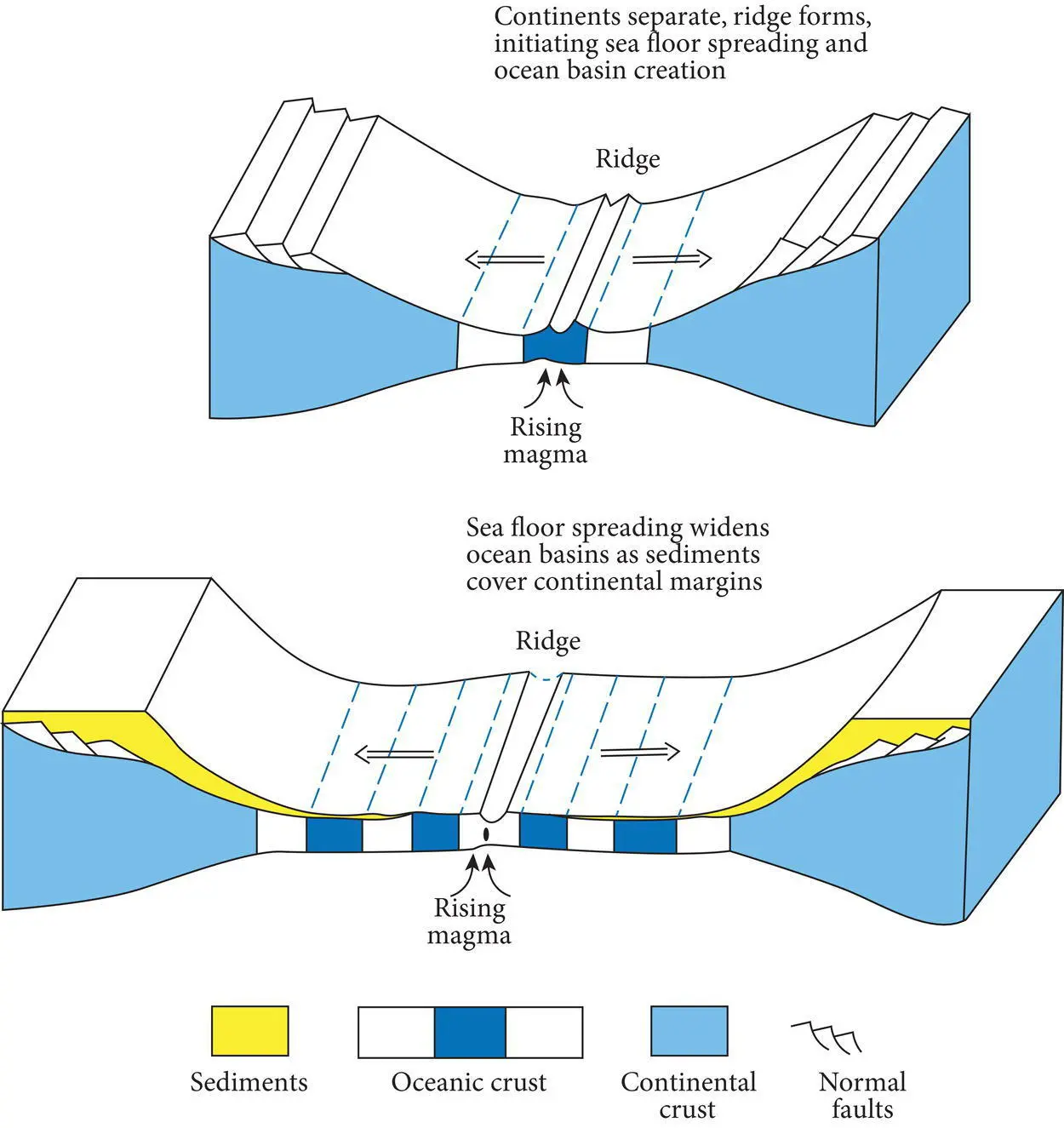
Figure 1.6 Model showing the growth of ocean basins by sea floor spreading from the ridge system following the complete rifting of continental lithosphere along a divergent plate boundary. Separated continental crust (light blue, topped with yellow sediments) and recently formed oceanic crust (dark blue striped pattern) are produced.
Oceanic ridge system
The oceanic ridge system (ridge)is Earth's largest mountain range and covers roughly 20% of Earth's surface ( Figure 1.7). The ridge is >65 000 km long, averages ~1500 km in width and rises to a crest with an average elevation of ~3 km above the surrounding sea floor. A moment's thought will show that the ridge system is only a broad swell on the ocean floor, whose slopes, on average, are very gentle. Since it rises only 3 km over a horizontal distance of 750 km, the average slope is 3 km/750 km which is about 0.004; the average slope is less than half a degree. We often exaggerate the vertical dimension on profiles and maps in order to make the subtle stand out. Still there are differences in relief along the ridge system. In general, warmer, faster spreading portions of the ridge such as the East Pacific Rise (~6–18 cm/yr) have gentler slopes than colder, slower spreading portions such as the Mid‐Atlantic Ridge (~2–4 cm/yr). The central or axial portion of the ridge system is commonly marked by a rift valley, especially along slower spreading segments. This marks the position of a divergent plate boundary in oceanic lithosphere ( Figure 1.7).
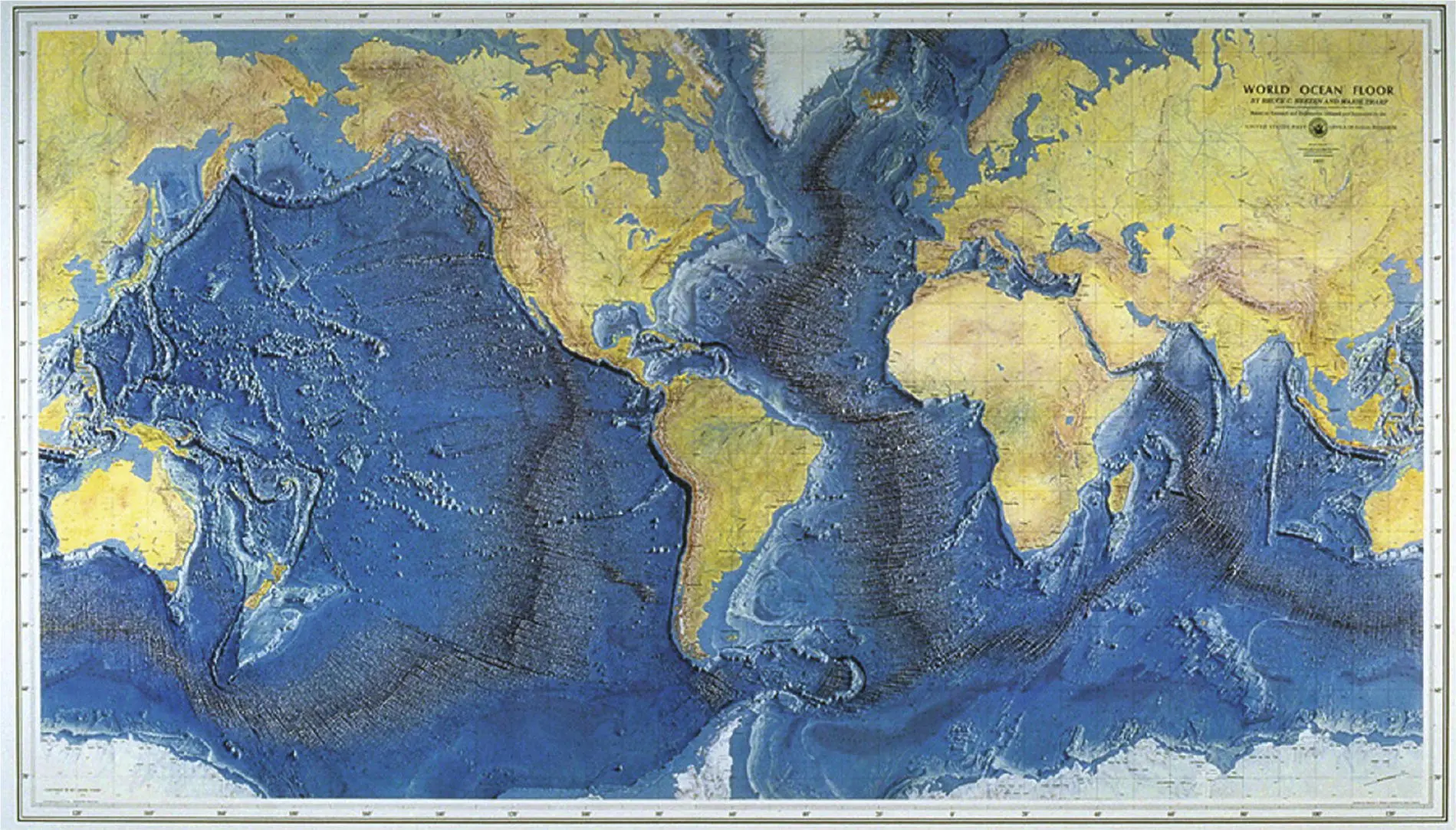
Figure 1.7 Map of the ocean floor showing the distribution of the oceanic ridge system.
Читать дальшеИнтервал:
Закладка:
Похожие книги на «Earth Materials»
Представляем Вашему вниманию похожие книги на «Earth Materials» списком для выбора. Мы отобрали схожую по названию и смыслу литературу в надежде предоставить читателям больше вариантов отыскать новые, интересные, ещё непрочитанные произведения.
Обсуждение, отзывы о книге «Earth Materials» и просто собственные мнения читателей. Оставьте ваши комментарии, напишите, что Вы думаете о произведении, его смысле или главных героях. Укажите что конкретно понравилось, а что нет, и почему Вы так считаете.









